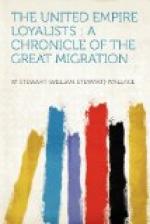CHAPTER XII
THE AMERICAN MIGRATION
From the first the problem of governing the settlements above Montreal perplexed the authorities. It was very early proposed to erect them into a separate province, as New Brunswick had been erected into a separate province. But Lord Dorchester was opposed to any such arrangement. ‘It appears to me,’ he wrote to Lord Sydney, ’that the western settlements are as yet unprepared for any organization superior to that of a county.’ In 1787, therefore, the country west of Montreal was divided into four districts, for a time named Lunenburg, Mecklenburg, Nassau, and Hesse. Lunenburg stretched from the western boundary of the province of Quebec to the Gananoqui; Mecklenburg, from the Gananoqui to the Trent, flowing into the Bay of Quinte; Nassau, from the Trent to a line drawn due north from Long Point on Lake Erie; and Hesse, from this line to Detroit. We do not know who was responsible for inflicting these names on a new and unoffending country. Perhaps they were thought a compliment to the Hanoverian ruler of England. Fortunately they were soon dropped, and the names Eastern, Midland, Home, and Western were substituted.
This division of the settlements proved only temporary. It left the Loyalists under the arbitrary system of government set up in Quebec by the Quebec Act of 1774, under which they enjoyed no representative institutions whatever. It was not long before petitions began to pour in from them asking that they should be granted a representative assembly. Undoubtedly Lord Dorchester had underestimated the desire among them for representative institutions. In 1791, therefore, the country west of the Ottawa river, with the exception of a triangle of land at the junction of the Ottawa and the St Lawrence, was erected by the Constitutional Act into a separate province, with the name of Upper Canada; and this province was granted a representative assembly of fifteen members.
The lieutenant-governor appointed for the new province was Colonel John Graves Simcoe. During the war Colonel Simcoe had been the commanding officer of the Queen’s Rangers, which had been largely composed of Loyalists, and he was therefore not unfitted to govern the new province. He was theoretically under the control of Lord Dorchester at Quebec; but his relations with Dorchester were somewhat strained, and he succeeded in making himself virtually independent in his western jurisdiction. Though he seemed phlegmatic, he possessed a vigorous and enterprising disposition, and he planned great things for Upper Canada. He explored the country in search of the best site for a capital; and it is interesting to know that he had such faith in the future of Upper Canada that he actually contemplated placing the capital in what was then the virgin wilderness about the river Thames. He inaugurated a policy of building roads and improving communications which showed great foresight; and he entered upon an immigration propaganda, by means of proclamations advertising free land grants, which brought a great increase of population to the province.




